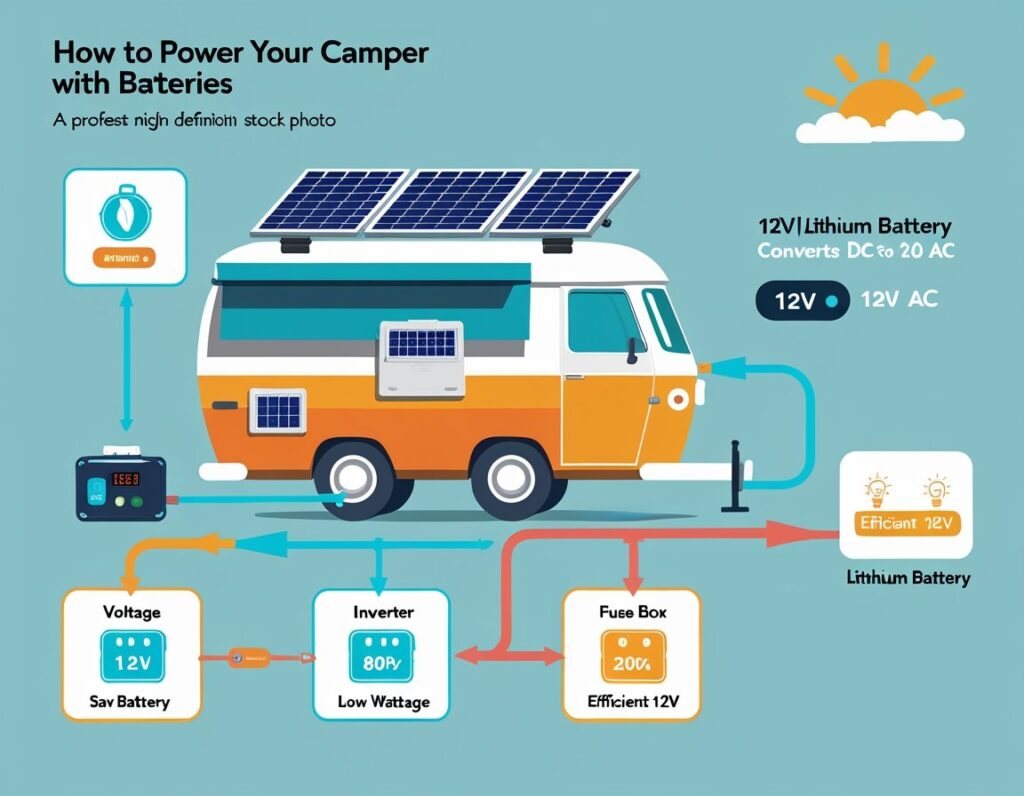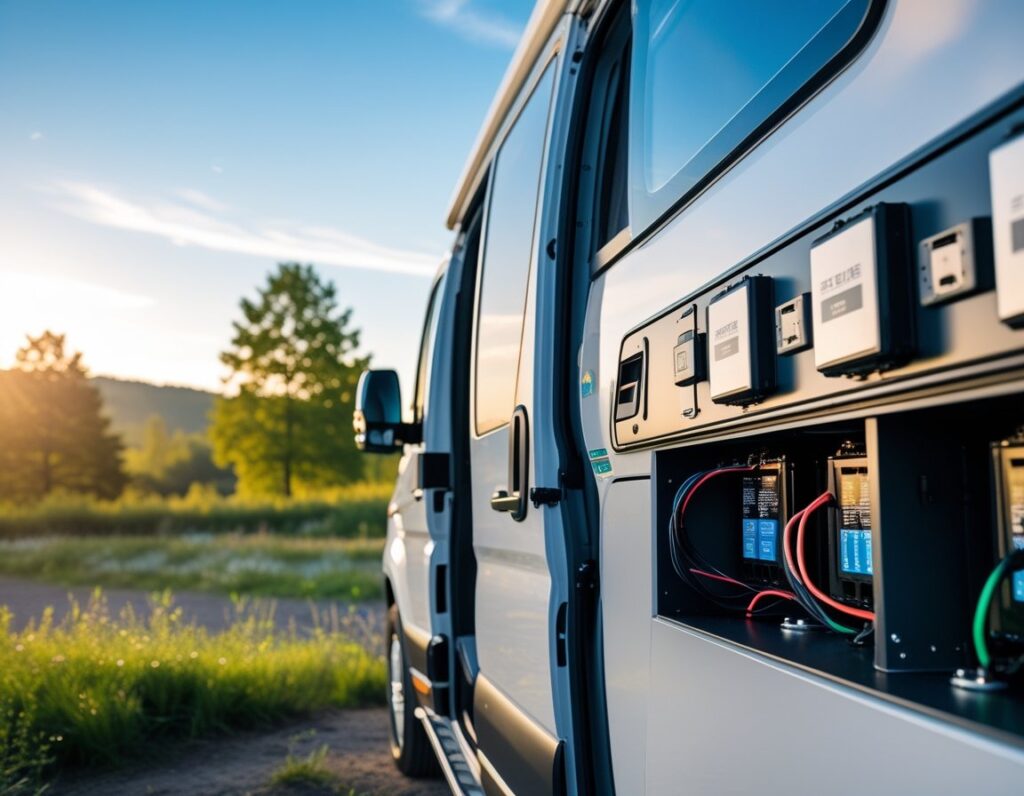How To run a camper on battery, install a deep-cycle battery and connect it to your camper’s electrical system. Ensure all appliances are compatible with the battery.
Running a camper on battery power offers freedom and flexibility for off-grid adventures. A reliable deep-cycle battery is essential for powering lights, appliances, and other electronic devices in your camper. These batteries are designed to provide a steady flow of power over an extended period.
Proper installation and maintenance ensure efficient energy use and longevity. Ensure all your camper’s electrical components are compatible with battery power. By understanding your energy needs and managing consumption, you can enjoy a seamless camping experience without relying on traditional power sources.
Choosing The Right Battery
Running a camper on a battery requires choosing the right battery. The correct battery ensures your camper runs smoothly and efficiently. Understanding the different types of batteries and their capacities helps in making an informed decision.
Types Of Batteries
There are several types of batteries suitable for campers. Each has unique features and benefits.
- Lead-Acid Batteries: These are the most common. They are affordable and reliable.
- AGM (Absorbed Glass Mat) Batteries: These are maintenance-free and have a longer life.
- Lithium-Ion Batteries: These are lightweight and have a high energy density. They are also more expensive.
Battery Capacity And Specifications
Understanding battery capacity and specifications is crucial. This ensures the battery meets your camper’s power needs.
| Specification | Description |
|---|---|
| Capacity (Ah) | This measures the battery’s energy storage. Higher capacity means longer use. |
| Voltage (V) | Most camper batteries are 12V. Ensure compatibility with your camper’s system. |
| Cycle Life | This indicates the number of charge/discharge cycles. A higher cycle life means a longer-lasting battery. |
Essential Equipment

Running a camper on battery power requires specific equipment. Having the right gear ensures you stay powered up on the go. This section covers the essential equipment needed for a smooth experience.
Inverters And Chargers
Inverters convert DC power from your battery to AC power. This is necessary to run standard appliances. Choose an inverter based on your power needs. A pure sine wave inverter is ideal for sensitive electronics.
Chargers keep your battery full. They can connect to shore power or a generator. A smart charger adjusts the charge rate. This prevents overcharging and extends battery life.
Here’s a simple table for quick reference:
| Equipment | Function | Notes |
|---|---|---|
| Inverter | Convert DC to AC | Choose pure sine wave for sensitive electronics |
| Charger | Replenish battery | Use a smart charger to prevent overcharging |
Solar Panels And Generators
Solar panels are a great way to charge your battery. They harness energy from the sun. Solar panels are quiet and eco-friendly. Install them on the roof of your camper.
Generators provide backup power. They run on fuel and can charge your battery quickly. Use them when solar power is not available. Choose a generator based on your power needs.
Here’s a quick comparison:
| Equipment | Pros | Cons |
|---|---|---|
| Solar Panels | Eco-friendly, Quiet | Depends on sunlight |
| Generators | Reliable, Quick charge | Noisy, Requires fuel |
Combine both for a reliable power setup. This ensures you always have power. Enjoy your camper adventures without worry.
Installing The Battery System
Installing a battery system in your camper can seem daunting. But with the right steps, it becomes simple. The battery system powers lights, appliances, and other essentials. This guide will help you install your battery system correctly.
Step-by-step Installation
Follow these steps to install your battery system:
- Choose the Right Battery: Select a deep cycle battery for better performance.
- Find a Suitable Location: Place the battery in a ventilated area.
- Install the Battery Tray: Secure the battery tray to prevent movement.
- Mount the Battery: Place the battery on the tray and secure it.
- Connect the Battery Cables: Attach the positive and negative cables to the battery.
- Install a Fuse: Add a fuse close to the battery for safety.
- Connect to the Inverter: Link the battery to the inverter for AC power.
- Test the System: Turn on the system and check all connections.
Safety Precautions
Always follow these safety precautions:
- Wear Protective Gear: Use gloves and safety goggles.
- Disconnect Power: Ensure all power sources are off before starting.
- Check Ventilation: Ensure proper ventilation to avoid gas buildup.
- Avoid Sparks: Keep flammable materials away from the battery.
- Follow Instructions: Read and follow the battery manufacturer’s instructions.
Battery Maintenance
Battery Maintenance is crucial for running your camper smoothly. Proper care extends battery life and ensures reliable power. Follow these steps to keep your battery in top condition.
Routine Checks
Conducting routine checks is essential for battery health. Inspect the battery terminals regularly. Ensure they are clean and free of corrosion. Use a mixture of baking soda and water to clean them if needed.
Check the battery voltage with a multimeter. A fully charged battery should read around 12.6 volts. If the voltage is lower, it may need charging or replacement.
| Task | Frequency |
|---|---|
| Inspect Terminals | Monthly |
| Check Voltage | Monthly |
| Clean Terminals | As Needed |
Troubleshooting Common Issues
Identifying and fixing common battery issues can prevent bigger problems. Here are some tips:
- Battery not holding charge: Check for loose connections. Tighten any loose cables. If the problem persists, the battery might need replacement.
- Corroded terminals: Clean with a baking soda solution. Apply a terminal protector spray to prevent future corrosion.
- Low voltage: Charge the battery fully. If it doesn’t hold the charge, test it with a load tester.
By following these steps, you ensure your camper battery remains reliable. Regular maintenance and timely troubleshooting keep your trips enjoyable.
Maximizing Battery Life
Running a camper on battery power can be challenging. Your goal is to maximize battery life. This section will guide you through the best practices. Learn how to make your battery last longer with simple tips.
Energy-efficient Appliances
Using energy-efficient appliances makes a big difference. Choose appliances with low power consumption. This helps your battery last longer. Look for LED lights instead of regular bulbs. LED lights use less power and last longer.
Solar panels can also help. They charge your battery during the day. This gives you more power for the night. Many campers use solar panels for this reason.
Here’s a quick list of energy-efficient appliances to consider:
- LED lights
- Portable solar panels
- Low-power fans
- Energy-efficient fridge
Smart Power Management
Smart power management is key to maximizing battery life. Use a power inverter to convert DC power to AC power. This allows you to use regular household appliances.
Install a battery monitor. It shows you how much power you have left. This helps you manage your usage better.
Follow these steps for smart power management:
- Install a power inverter.
- Use a battery monitor.
- Turn off appliances when not in use.
- Charge devices during the day.
Here’s a table of smart power management tools:
| Tool | Benefit |
|---|---|
| Power Inverter | Converts DC to AC power |
| Battery Monitor | Tracks power usage |
Always check your battery levels. Avoid running out of power. With these tips, you can enjoy a longer battery life.
Staying Powered Up
Running a camper on battery is great for off-grid adventures. It allows you to enjoy nature while staying connected. This section will help you stay powered up efficiently.
Charging Options
There are several ways to keep your camper’s battery charged. Choose the one that suits your needs best.
- Solar Panels: Solar panels are eco-friendly and quiet. They convert sunlight into electricity. Mount them on your camper’s roof for continuous charging.
- Generator: Generators are reliable and versatile. They can power your camper and charge your battery. Make sure to use a generator with the right wattage.
- Shore Power: Shore power means plugging into an electrical outlet. Many campsites offer this service. It’s a quick way to charge your battery.
- Alternator: The alternator charges your battery while you drive. This option works well for road trips.
Managing Power Consumption
Managing your power consumption is crucial. Use energy wisely to make your battery last longer.
| Device | Power Usage | Tips |
|---|---|---|
| Lights | Low | Use LED bulbs, they use less power. |
| Fridge | Medium | Keep it full, it runs more efficiently. |
| Heater | High | Use blankets to stay warm at night. |
| Devices | Varies | Charge phones and laptops during the day. |
- Monitor Usage: Keep an eye on your battery level. Use a battery monitor.
- Unplug Devices: Unplug devices when not in use. This prevents phantom power drain.
- Use Efficient Appliances: Choose energy-efficient appliances. They use less power.
By following these tips, you can stay powered up. Enjoy your off-grid adventures without worry.
Real-life Off-grid Tips
Running a camper on battery power can be challenging yet rewarding. Discover real-life tips to make your off-grid experience successful. Learn from others who have mastered the art of living off the grid.
Success Stories
Many adventurers have successfully used batteries for their campers. Here’s what they’ve shared:
- John’s Journey: John used a combination of solar panels and deep-cycle batteries. His setup allowed him to stay off-grid for weeks. He installed a 200W solar panel and two 100Ah batteries. This setup powered his lights, fridge, and small appliances.
- Emma’s Experience: Emma traveled through remote areas using lithium-ion batteries. She found them lightweight and efficient. Her system included a 100Ah battery and a 150W solar panel. Emma managed to stay off-grid for extended periods.
Lessons Learned
These adventurers also learned valuable lessons. Here are some key takeaways:
- Battery Maintenance: Regularly check your batteries to ensure they are in good condition. Avoid deep discharges to prolong battery life.
- Energy Efficiency: Use energy-efficient appliances and LED lights. This helps conserve battery power. Turn off devices when not in use.
- Solar Panel Positioning: Place solar panels in direct sunlight. Adjust their angle for maximum exposure. Clean panels regularly to maintain efficiency.
| Tips | Details |
|---|---|
| Battery Type | Choose between deep-cycle and lithium-ion batteries based on needs. |
| Charging Options | Consider solar panels, portable generators, or vehicle alternators. |
| Backup Plan | Have a backup power source, like a small generator, for emergencies. |
Frequently Asked Questions
How Long Can A Camper Run On Battery?
The duration depends on the battery capacity and energy usage. Typically, a camper can run for 1-3 days.
How Do You Charge A Camper Battery?
Charge a camper battery using solar panels, a generator, or shore power. Ensure proper connections and monitor charging levels.
What Appliances Can Run On A Camper Battery?
Lights, fans, and small electronics can run on a camper battery. Avoid using high-wattage appliances like air conditioners.
How To Conserve Battery Power In A Camper?
Turn off unnecessary lights and appliances. Use energy-efficient devices. Monitor battery levels regularly to avoid depletion.
Conclusion
Running a camper on battery power is simpler than it seems. Follow the steps and tips provided. Enjoy seamless camping experiences with the right setup. Remember to monitor battery levels and maintain your equipment. Happy camping and safe travels!


